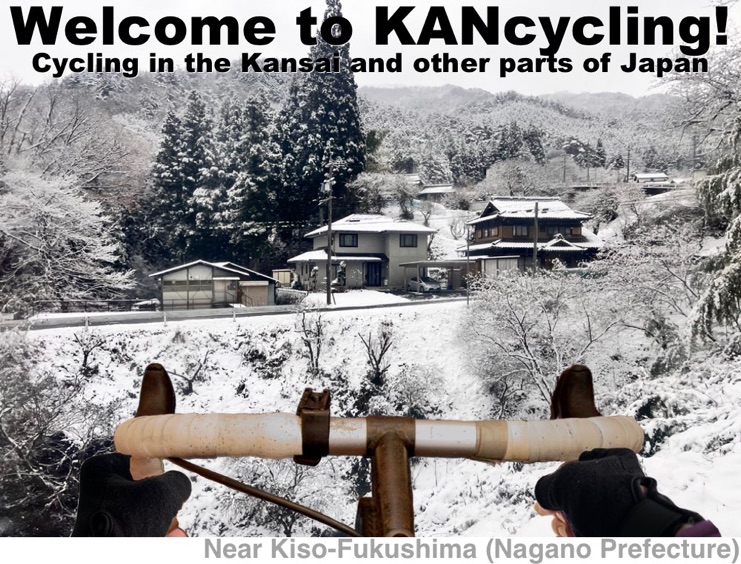New to KANcycling?
Click DESTINATIONS and MAP to see cycle trips
Click BASICS to see how it’s done
Click RESOURCES for more information
Comments? Questions? Tips? Click EMAIL

















New to KANcycling?
Click DESTINATIONS and MAP to see cycle trips
Click BASICS to see how it’s done
Click RESOURCES for more information
Comments? Questions? Tips? Click EMAIL
TIP LINE
Even though we might not always update in a timely fashion due to the constraints of RL (real life), we very much appreciate the information sent to us by readers. Thanks again, and please keep the tips coming.
TRAVELING BY BICYCLE
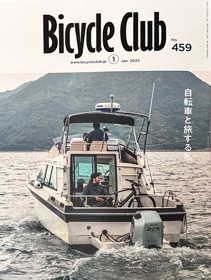
However, at year’s end Cycle Sports issued a massive new route guide entitled (in Japanese) “Japan’s Best Cycle Journeys.” Does it live up to the hype?
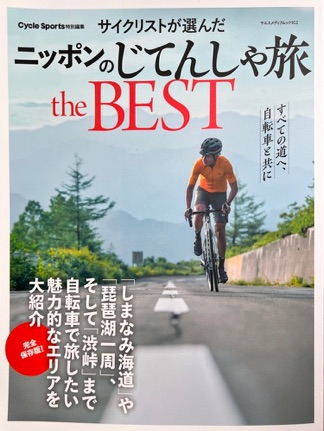

100 KM RIDE PLANNING
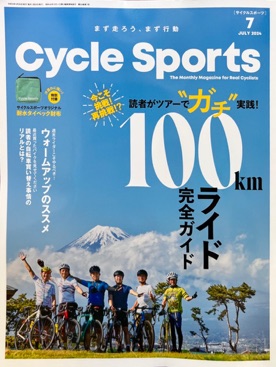
RAIL LINES & GREAT VIEWS

HAPPY NEW YEAR 2024!

Best wishes for great rides in 2024!
ZEKKEI CYCLING TABI


SOLO CYCLING + HOT SPRINGS


OSAKA vs TOKYO CYCLING + RAIL

The guide offers a few routes in each city as well as a detailed comparison of the best attributes of each of these very different metropoles.


JULY 2023 CYCLING MAGAZINES

”KIGARU” ROUTES AND JITENSHA-TABI


HAPPY NEW YEAR!
Here’s our New Year’s card for 2023:

Best wishes for 2023 to bring many things
— a definitive end to the COVID crisis, more opportunities for interchange and companionship, and most importantly great routes and rides through every part of Japan.
YEAR-END MAGAZINES & BOOKS
Meanwhile, three year-end Japanese cycling guides suggest cycling not just for scenery but also history, as noted in our latest Cycling Special Report.
NEW GUIDE: “KANSAI CYCLING”

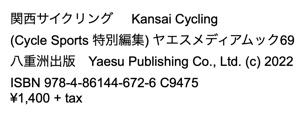
NOVEMBER CYCLING MAGAZINES

The monthly Cycle Sports has a 14-page feature on four routes in northern Ibaraki Prefecture. And the bimonthly Bicycle Club is a cornucopia of articles for bike travelers: the main article is entitled “Finding Japan on the Bike” (though the Japanese actually says “rediscovering”) with helpful hints from bike travel route creators, and other articles focus on a 120km ride from Tokyo to Utsunomiya via Nikko, the steep 22km ascent of Mt. Ishizuchi in Ehime, and a camping car & cycling trip along the Pacific Bicycling Road running from Chiba to Wakayama Prefectures. Both magazines also contain freebies: a waterproof shoulderbag for Cycle Sports and, from Bicycle Club, a metal case for tools with a retro design reminiscent of a miniature elementary school kid’s lunchbox. Both in bookstores now; get yours before they’re all gone.
BREAKING: OCTOBER 11
Last night the news we’ve been waiting for broke: October 11. As reported by Kyodo News and the Japan Times, on that day the cap on daily arrivals disappears, and more importantly (drum roll) “visa-free individual trips” are permitted again, meaning that solo cyclists are finally allowed to come to Japan. (Travelers will still need to be thrice-vaccinated or submit a negative COVID test on arrival.) We’ll issue another COVID report, hopefully the last for awhile, when the date is a bit closer. For now, rejoice: finally cyclists will be able to visit Japan again.
FINALLY: OCTOBER
Both Kyodo News and the Japan Times report further planned loosening of entry restrictions. Kyodo says the cap on daily arrivals will be removed by “the end of October.” But it’s once again the Japan Times that has the biggest news, stated right in its headline: “Japan plans to reopen to independent travelers in major shift.” Quoting Fuji TV, the article says:
The government is planning to allow independent tourists to come to Japan and exempt them from visas if they have been vaccinated three times or submit a pre-arrival test result.”
The official announcement is expected as early as the end of this week and the new policy reportedly will be implemented “by October.” More after the official announcement.
A CRACK WIDER, BUT NOT FULLY OPEN
As our latest COVID update indicates, as of yesterday, Japan has opened up a bit more, but not all the way. Guides are no longer required, but package tours and visas still are. PCR tests on entry are not required if you’ve had 3 vaccine shots, but are required for everyone else. And the quarantine time for symptomatic COVID has been cut from 10 to 7 days (or to 5 days with a negative test). Needless to say, the need to reserve hotel rooms in advance throughout one’s stay is likely to be very inconvenient for cyclists wanting to tour the country. More information at the link.
BREAKING: SOLO TOURISTS STILL BANNED
Reporting by some outlets (Kyodo News, Forbes etc.) on the new policy coming into effect on September 7 seems to miss the crucial point that is made clear by the Japan Times: although visitors to Japan will no longer need to be on guided tours, they will still need to be on a "package tour" (which will be defined later) so “… individual tourists, such as backpackers traveling without a sponsor, won’t be allowed in.” Other changes: visas will still be required, but thrice-vaccinated visitors will not need to show a negative PCR test upon arrival, and the daily arrival cap will be raised to 50,000. More details as things become clearer.
“CHILL CLIMBS”


AUGUST IN INADANI

YUP, ONLY GROUP TOURS
The Japan Times (registration may be required to view) reports that “tourists on package tours with guides” will be allowed into Japan starting June 10. It quotes the Prime Minister as saying: “Step by step we will aim to accept (tourists) as we did in normal times, taking into consideration the status of infections."
This is pretty much what we expected, and why we cautioned that Japan’s re-opening to tourism was likely to be slow. In its reporting of the announcement, Kyodo News adds that international flights to Naha (Okinawa) and Chitose (Hokkaido) will also resume in June.
Sigh. Stay tuned.
MAYBE ONLY GROUP TOURS?
An announcement is expected as early as today about tourism reopening, but the NHK-FM 7:00 a.m. news (in Japanese) this morning reported that (a) tourists will be INCLUDED in the daily 20,000 persons allowed into the country, not in addition to that number, and (b) “a proposal to limit tourists to only those on group tours is being considered.” As we wait for the official announcement, here is the exact wording of that part of the NHK report:

MAYBE JUNE AFTER ALL?!
Japan’s full reopening may happen in June after all. Kyodo News reports that the cap on new overseas arrivals will double to 20,000, and Time Out reports that this will begin June 1 but “the move does not include allowing general tourism.” Yet there are encouraging signs. Testing and quarantine will be loosened considerably (although Kyodo says that a pre-departure test will still be needed). Countries and regions will be divided into red, yellow and blue groups based on infection rate. Blue group travelers will be exempt regardless of vaccination status; Yellow group travelers will be exempt if they have had three vaccinations with government-approved COVID vaccines.* However, none of these media outlets say anything about “tourism” specifically, much less whether non-group-tour travelers will be admitted. The passage (reported by Kyodo) that gives rise to the most optimism is probably this one:
Travelers from the lowest-risk "blue" group will be exempt from testing upon arrival in Japan and quarantining at home, Chief Cabinet Secretary Hirokazu Matsuno told a press conference. They will still need to show a pre-departure negative test result.
Around 80 percent of entrants are likely to be from countries and regions that fall into that group, Matsuno said, adding that the breakdowns will be announced next week.
So there is definitely forward momentum, but still no definite word on whether this means full tourist opening is imminent. Supposedly a formal announcement is coming this week; stay tuned.
* The Japanese document lists Pfizer, Moderna, AstraZeneca, Janssen, Bharat Biotech and Novavax vaccines for the first two shots and Pfizer, Moderna and Novavax for the third and subsequent shots. Conditions apply; see the Japanese document here.
TOURISM TO RESUME — S L O W L Y
Japan will finally begin admitting tourists again — but the opening will be slow. A pilot program will begin in June, limited to group tours on fixed itineraries. Only after that will general tourists be allowed in, and that will undoubtedly be gradual as well (since Japan currently limits the daily number of students and business travelers, although it keeps raising the caps). Note that, even when things do open up, visitors may need to be vaccinated and boosted. For details, see our latest COVID update here.
CYCLING HIDA NO SATO - NOT
About our top photo, before you ask: no, you can’t actually cycle inside Hida no Sato. But the picture shows how lovely the spring greens are right now, and you can get very similar views in the area.
MAY CYCLE MAGAZINES
The major May cycle magazines both contain freebies: Cycle Sports offers a plastic mudguard attachment (emblazoned with “Eat My Dust” in English), while Bicycle Club (a bimonthly now, by the way —only issued once every two months) offers a nice stem bag. Both also feature route articles: BC with a two-day 500km route between Osaka and Tokyo (overnighting near Hamamatsu), and CS features a shorter piece entitled “Kamakura-dono Historical Cycle Ride” that’s apparently inspired by this year’s NHK Taiga Drama “The 13 Lords of the Shogun” about the Kamakura shogunate. Both available in cycle shops and bookshops now; get yours before they’re all gone.
UPDATED COVID REPORT
Our updated COVID report is here.
JAPAN STARTING TO OPEN UP?
Despite the sky-high Omicron case numbers in Japan, Kyodo News reports that Japan plans to relax restrictions on entry in March. The bad news is that, initially at least, this will target only business travelers and students. Neither the original Nikkei report (which is here) nor the Prime Minister in his remarks mentioned anything about when tourists might be admitted. So cycle-tourists may have to wait a bit longer to start planning their trips.
Our prediction: don’t expect restrictions on tourist entry to change until the Omicron wave subsides and things warm up in the spring.
CLICK HERE FOR COVID IN JAPAN NEWS
WHAT’S NEW
HAPPY NEW YEAR!

Here’s hoping for great rides in the Year of the Snake!

